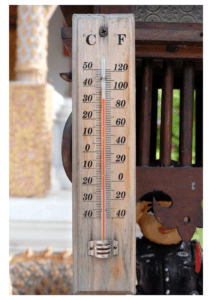To understand how to convert Celsius to Fahrenheit (and vice versa), let’s first explore the main differences between the two temperature scales. (If you want to know how to convert between the two scales, scroll to “Celsius to Fahrenheit Formula” below.)
Students need to convert between Celsius and Fahrenheit when they transition between metric units (i.e. degrees Celsius, often abbreviated ºC) and imperial units (i.e. degrees Fahrenheit, often abbreviated ºF). In the United States, the metric—or International—System of units (think centimeters, meters, kilograms, milliliters, etc.) is most often encountered in science and engineering contexts. By contrast, imperial units (like inches, feet, pounds, gallons) are the standard units of measure in most day-to-day situations in the U.S.
The United States’ general preference for imperial units is unusual. Only four other countries (Belize, the Cayman Islands, Palau, and the Bahamas) employ imperial units (including degrees Fahrenheit) as their preferred system of measurement. And Imperial units are almost never used in science and engineering, regardless of location.
On the Fahrenheit scale, the temperature will be given in degrees Fahrenheit. Celsius and Fahrenheit have a proportional relationship. Both have a different freezing point for water, and both scales have different unit differences. As a result, the Celsius to Fahrenheit formula is often known as the Celsius to Fahrenheit conversion formula.

Your College Admissions Journey, Mapped Out!
Introducing our college planning timeline with a handy checklist of essential tasks, a step-by-step guide for every grade level, from freshman to senior year, AND financial aid, college applications, extracurricular activities, and more.
The History of Celsius and Fahrenheit
The history of the two competing temperature scales is fascinating. Named after German physicist Daniel Gabriel Fahrenheit (1686-1736), the Fahrenheit temperature scale is the older of the two, dating to 1724. Fahrenheit had already revolutionized the measurement of temperature when he developed the mercury-in-glass thermometer in 1714, but his introduction of the Fahrenheit scale proved equally popular. Fahrenheit organized his scale by using the freezing temperature of a saltwater brine to define 0º and the (incorrectly determined) temperature of the human body as 90º. Fahrenheit also determined that using his scale, water (at sea level) freezes at 32° and boils at 212°. The Fahrenheit scale was soon widely accepted as a standard means of measuring temperature, especially in the English-speaking world.
The Celsius scale, originally called the centigrade scale, was developed in 1742 by the Swedish astronomer Anders Celsius. Celsius designed his scale so that exactly 100º separates the freezing and boiling points of water at sea level. Though it has been repeatedly tweaked over the centuries, as the Celsius scale is presently constituted, water freezes at 0° and boils at 100°. The scale was popularized when, in 1799, as part of its revolutionary project, the French government adopted the metric system—and the Celsius temperature scale along with it.
Celsius to Fahrenheit Formula
The Celsius to Fahrenheit formula converts a given temperature in degrees Celsius to a temperature in degrees Fahrenheit. We know that water’s freezing point is 0º Celsius or 32º Fahrenheit and that its boiling temperature is 100º Celsius and 212º Fahrenheit.
As the figure of a thermometer above demonstrates, in Celsius, 100º separates the two points; whereas, in Fahrenheit, 180º does so. Using these two values, we can now create a proportion of degrees Fahrenheit to degrees Celsius, getting 180/100, which reduces to 9/5. In other words, a 9º change in Fahrenheit is equal to a 5º change in Celsius. But, it’s important to remember that the two scales define 0 differently. Because 0º in Celsius (the freezing point of water) is 32º Fahrenheit warmer than 0º in Fahrenheit, to convert a temperature to Fahrenheit requires that we give the temperature a 32º boost (or, in algebraic terms, add 32). In the end, the formula for converting Celsius to Fahrenheit is:
°F = °C (9/5) + 32
How to Convert Celsius to Fahrenheit?
To convert Celsius to Fahrenheit, we take the formula above and solve it for ºF in terms of ºC, which gives us:
ºC = (5/9) (ºF – 32)
Temperature Conversions in °C and °F Table
But Formulas can be pretty abstract. It’s, therefore sometimes useful to know how certain notable temperatures, such as body temperature and the freezing and boiling points of water, appear in both scales. You can find some common temperature conversions in the chart below:
| °C | °F | Description |
| -40 | -40 | This is where Fahrenheit equals Celsius, also known as the point of parity between the two scales, roughly the average wintertime temperature at the North Pole. |
| -18 | 0 | A cold winter day |
| 0 | 32 | The freezing point of water |
| 10 | 50 | A cool day |
| 21 | 70 | Typical room temperature |
| 30 | 86 | A hot day |
| 37 | 98.6 | Body temperature |
| 40 | 104 | Bath water temperature |
| 100 | 212 | Boiling point of water at sea level |
| 180 | 356 | A typical baking temperature in an oven |
Where:
- Temperature is measured in degrees Celsius (°C).
- Temperature is measured in degrees Fahrenheit (°F).
We can use the steps below to convert Celsius to Fahrenheit:
Step 1: Determine the Celsius temperature value.
Step 2: Take the given temperature and multiply it by 9.
Step 3: Divide the result by 5.
Step 4: Increase that number by 32. The needed temperature in degrees Fahrenheit (°F) will be the desired result.
Examples
- Convert 30° Celsius to Fahrenheit.
As we know that
°F = °C + 32 (9/5)
Because, in our problem, °C = 30, we can replace the ºC in the equation with 30, giving us:
°F = 30 + 32 (9/5)
°F = (30 × 9)/5 + 32
°F = 270/5 + 32
°F = 54 + 32
°F = 86
So, 30° C = 86° F.
- Convert 50° Fahrenheit to Celsius.
As we know,
ºC = (5/9) (ºF – 32)
So, because in this problem °F = 50, we can replace the ºF in Equation with 50, so:
ºC = (5/9) (50 – 32)
ºC = (5/9)(18)
°C = 90/9
°C = 10
So, 50° F = 10° C
For more information about the SAT read these posts:
ACT or SAT: Which Test do Elite Universities Prefer?
What Does Test-Optional Really Mean?
And remember, if you need tutoring on this or any other math concept, we are here to help. HelloCollege offers expert tutoring in every subject for every grade level, to students just like you. Reach out today to learn how we can help make your life easier!




